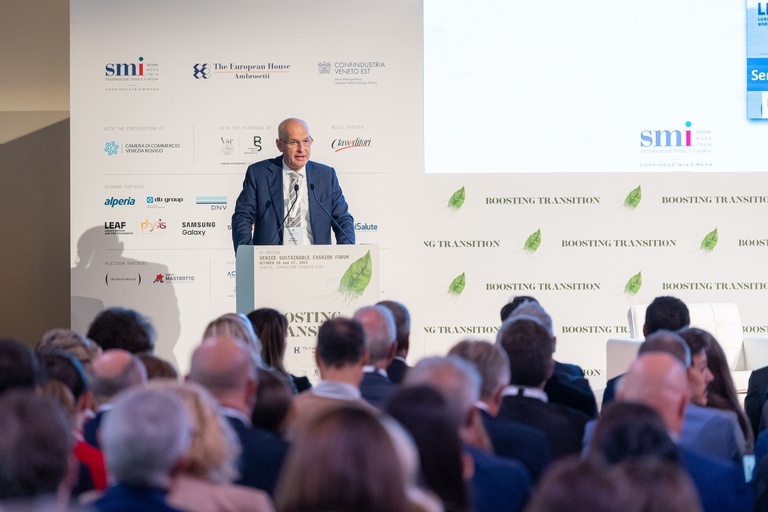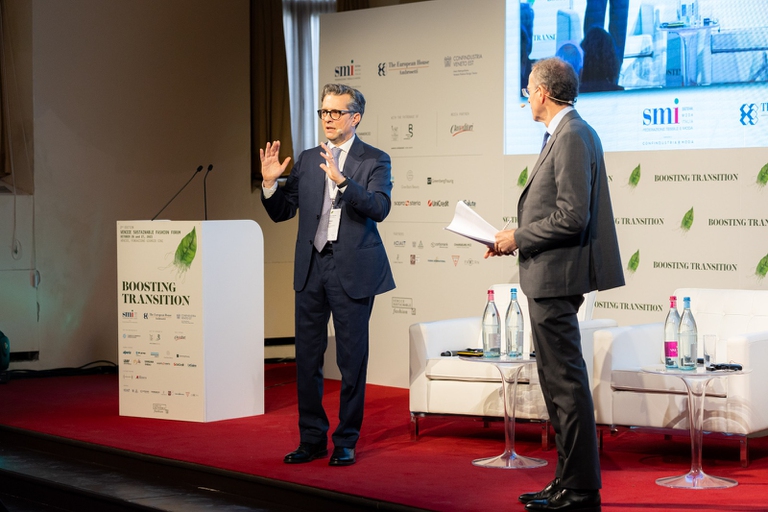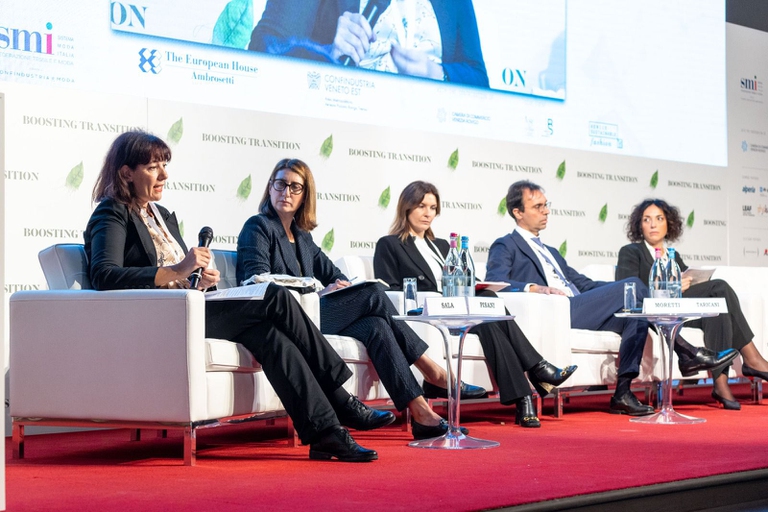https://www.lifegate.it/venice-sustainable-fashion-forum
- |
Password: accelerate.It seems like we've already heard it too much in all sectors.In this case, we were talking about the transition of fashion to the second edition of Venice sustainable fashion forum, organized on 26 and 27 October 2023 by Sistema Moda Italia, the European House Ambrosetti and Confindustria Veneto Est. Boosting Transition was the title of the two days which, despite a certain hyper-positive rhetoric on Made in Italy, certainly had the merit of gathering the needs and difficulties of a system that finds itself at a decisive crossroads.As Sergio Tamborini, president of Sistema Moda Italia, said:“The paradigm shift is an irreversible process for rewrite the fate of Italian manufacturing.The circular one is a supply chain that needs to be completely reinvented, accompanied by an alternative vision of the economy and consumption."

It is no coincidence, however, that the most critical voices of the Venice sustainable fashion forum whether those of foreigners or those who work in international institutions, who manage to have a more objective vision of the state of fashion in Italy.Italian manufacturing is synonymous with excellence, true, there is certainly a desire to change, but why are we so late even compared to our French cousins who have already set up a better circular system and the so-called Extended producer responsibility?
The initial greetings came from the European Commissioner for the Environment Virginijus Sinkevičius, who with a smile recalled the legislative tsunami that is about to hit the entire European textile and manufacturing industry:“You can do it, after all, change is the essence of fashion,” he told an audience of 400 industry insiders, supply chain entrepreneurs and sustainability managers.
The topic of legislation is also the first point of the study Just Fashion Transition 2023 presented by Carlo Cici, Sustainability Area Manager of The European House Ambrosetti.The study collected data from 2,800 Italian and European companies in the fashion and textile sectors.These are the 7 main findings of the study (there is no shortage of considerations on the role of consumers).

1.Where self-regulation does not arrive, the European Union arrives
There are between 14 and 16 legislative actions that will soon affect the European textile sector and, consequently, the fashion sector.Starting from EU Textile Strategy, launched in 2022, legislative pressure seems to be the only solution to definitively accelerate the transition in this sector.For example, the Ecodesign regulation provides specific design rules for product categories in order to improve their circularity and impact (one circular fashion with garments and objects that are more easily disassembled and made of easily recyclable materials).However, the Forum was reminded that recycling cannot be the panacea, also because we currently have only part of the technologies necessary for fabric-to-fabric recycling and, furthermore, we are not able to manage the volumes of textile waste that we produce (from 2025 the separate collection of textiles).The greatest revolution will come from the application of Extended Producer Responsibility – EPR, or the taking charge of the end of life of the product by those who produce it.

2.We like sustainability, but who pays for it?
It has been calculated that a sustainable garment costs twice as much as a traditional one, but can be resold for four times as much.Is this good news given that average consumer spending is dropping dramatically in the meantime?The overall manufacturing cost for a traditional cotton t-shirt is approximately $3.87.The garment is then resold to the consumer at approximately twice the price (up to $8).Case studies show that producing a T-shirt from fair trade ethical cotton can cost up to $8.72 with a retail price of around $36 – four times the cost of production.Is there a way not to pass on this increase to the consumer but to internalize it at least in part?Who should bear the costs of the sustainable transition?These questions remain open and returned, in different forms, during the forum panels.
3.“Sustainable” fiber does not exist
The environmental and impact profile of textile fibres it is extremely complicated to outline, also due to a lack of sharing of data and measurement systems.According to the Just Fashion Transition 2023 study:“While natural fibers are commonly perceived as more environmentally friendly as they are renewable and biodegradable, data shows that, in some cases, they can exert greater environmental impacts than synthetic or artificial alternatives.”Cotton is an example of this, although today it is estimated that around 70 percent of the fibers used to make clothes and furnishing fabrics are synthetic (e.g.polyester and nylon).
The development of new technologies will be increasingly fundamental to lower the impact of the sector, not only recycling technologies (which use less water, less energy and produce better materials), but also more advanced tools for planning and design and Artificial Intelligence for predict sales and better manage all production steps.It was also remembered how the sustainability of a garment or accessory is directly linked to its period of use:the problem is those products with a large impact and a short period of use.This is why the role of consumers becomes crucial.
4.We need to change the way we buy fashion
Within a few years the so-called digital passport:each item of clothing must be accompanied by a set of certified data and information which, in a transparent and easily understandable way, explains the impact of that product.A real revolution that will respond to one of the most frequent complaints of those who shop, namely the lack of information and the lack of trust in the brands that offer it.
However, we must ask ourselves whether we will be able to understand this information, given the lack of knowledge of the topic of sustainability, and in addition the poor awareness of what it means to buy an item of clothing.For example, today about 30 percent of online purchases are returned, and 70 percent of these returns are the result of a “change of mind,” without realizing the repercussions:such as the sending of a large quantity of "unwanted" items to landfill.A considerable portion ends up in Africa, where more than 50 percent of used clothes immediately become waste.
5.Recycling must rhyme with reuse and more careful production
The waste issue was at the center of a debate at the Venice Sustainable Fashion Forum 2023:in Europe they are produced every year from 5.2 to 7.5 million tons of textile waste equal to approximately 26 billion items of clothing (with 20 percent growth expected by 2030).On average, out of 35 textile items thrown away, 3 are recycled and less than 1 is reused in the domestic market.The end of life of textile products is a central question:as mentioned, not only do we not have the technologies to manage these volumes, but it has been calculated that reuse allows us to avoid up to 97 percent of CO2 emissions and reduce water consumption by 99 percent compared to chemical recycling.And evidently reuse is linked to the quality of the product in question.
Fashion also stands out as the industry with the greater volume of waste exported towards non-OECD countries, a quantity that has increased fivefold in Europe alone in the last twenty years 1.7 million tons.European legislative limits will certainly be placed on these exports in the future, but, above all, as he recalled Chloe Asaam of The Or Foundation in Ghana, fashion must take responsibility for what it is unable to sell or what is thrown away by consumers. Lisa Lang, Director Policy & EU Affairs – KIC Climate, underlined that “overproduction is not just a problem of fast fashion but of the entire fashion system.It is estimated that fashion has an overproduction of parts by 30 to 40 percent (compared to 0.2 percent in the digital technology industry)”.

6.Human rights (especially of women), notable absentees from the forum
Although the companies present at the Venice sustainable fashion forum were mainly Italian, the theme of global supply chains it wasn't particularly highlighted.In addition to the aforementioned citizens of those countries who are literally suffocated by textile waste from the North of the world, there is also the lack of transparency and little knowledge of their supply chain, which is also directly linked to the management of Scope 3 emissions.
Always second Just Fashion Transition 2023:“10 years after the disaster of collapse at Rana Plaza, in Bangladesh, only 1.5 million workers out of the 75 million that make up the global sector receive a adequate salary and has formal employment contracts, stable working hours, or established protections under the labor law.The increase in labor rights violations in the fashion industry has been driven especially byincrease in forced labor, modern slavery and child labor.Working days of 10 to 18 hours are increasingly common, even 7 days a week in the busiest periods."Since it is known that about 80 percent of those 75 million workers are women (Clean Clothes Campaign data), it is clear who all this weighs most on.
7.Create a system, with suppliers and with finance
Transparently reporting your sustainability journey is no longer a voluntary choice.It will become mandatory for an ever-increasing number of companies, but for Italian manufacturing the pressure to do so is already driven primarily by fashion brands, which purchase semi-finished products, and by finance, which increasingly wants clear and certain data to give access to credit.Between 2021 and 2022, the number of European fashion companies addressing sustainability increased by 17 percent.
The study concludes with eight proposals for a just transition in global fashion, which summarize the key issues of the two-day Venice sustainable fashion forum 2023.The tools that the European Union is studying to accelerate the transition of the fashion system risk overwhelming an entire sector if they are not anticipated with adequate preparation by companies, forming alliances with partners and other players in the supply chain.This cannot ignore the promotion of a new model of fashion consumption:a real cultural change is needed to return to valuing the purchase of clothing.
